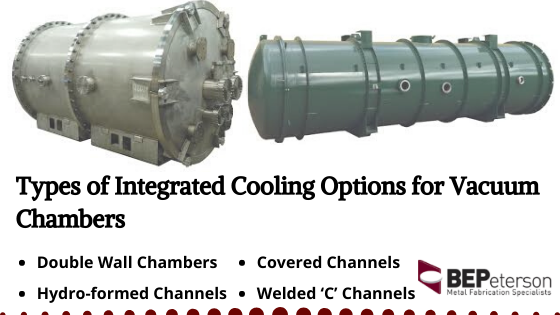Water cooling encompasses multiple ways of using water to evacuate heat from a thermal vacuum chamber. The three most prominent options are exterior, surface and integrated cooling. Variations exist for each of the three methods, which apply the methods’ basic concepts in designs optimized for different purposes.
At BEPeterson, we have evaluated the numerous types of cooling for vacuum chambers to determine which to incorporate into our designs. The vacuum chambers we manufacture feature integrated water cooling systems. We can help you understand how integrated water cooling works and why it is often the optimal method for vacuum chambers.
Why Do Vacuum Chambers Require Coolant?
Knowing the importance of efficient heat evacuation is crucial to understanding why the integrated water cooling method is best for vacuum chambers.
Vacuum chambers are rigid metal enclosures manufacturers use to test how products or components will perform under specific environmental conditions. By manipulating the presence of air and other gases inside the container, a vacuum chamber can produce a low-pressure environment with an extremely high or low temperature. These chambers are widely used for testing and producing equipment for numerous industries, including defense, aerospace, medicine, chemical, manufacturing and energy.
All vacuum chambers produce a high amount of thermal energy — heat. Although made of durable metals such as stainless steel, aluminum, hard steel or high-density ceramic, vacuum chambers are susceptible to damage from heat exposure. Additionally, excessive heat can overwork the chamber’s mechanical components, resulting in lost efficiency and equipment damage.
Allowing heat to accumulate in the vacuum chamber and its mechanical components can reduce efficiency and damage the system. Therefore, vacuum chambers require cooling systems that can quickly absorb, transfer and evacuate heat — core capabilities of the integrated water vacuum chamber cooling method.
Why Is Integrated Water Cooling Ideal for Vacuum Chambers?
Integrated water cooling is a unique method that, by running coolant channels through the chamber, can evacuate heat more thoroughly and efficiently than other methods. There are four types of integrated water cooling systems for vacuum chambers — double wall chambers, covered channels, welded C channels and hydro-formed channels.
Double Wall Chambers
A double wall or jacketed chamber is a vacuum chamber with an additional exterior layer for cooling. The additional layer forms water channels that allow coolant to flow along the hot chamber surface. These channels feature baffles that optimize circulation and flow, making double-wall chambers one of the most effective types of cooling systems for high-temperature vacuum chamber applications. Many jacketed vacuum chambers are fitted with double water-cooled walls, which ensure efficient heat removal.
Covered Channels
Many custom vacuum chamber manufacturers suggest channels or water traces for applications involving low heat loads. These covered channels or water traces are directly machined into the wall. The channels provide cooling paths that enable faster, more efficient cooling for vacuum chambers.
Welded C Channels
These cooling options are suited for vacuum chambers, which produce low heat loads. As the name suggests, these channels are welded onto the surface of the chamber to serve as cooling paths. Welded C channels are precisely milled into the wall for optimal thermal transfer efficiency.
Hydro-Formed Channels
A hydro-formed channel is a cost-effective heat transfer option that cools almost two times the surface area as welded C channels. The increased cooling surface area comes from radius bends, which help regulate water flow to prevent stagnation. Water pressure through the bends creates open flow paths within the cooling channels.
Cooling channels are directly welded into the chamber with fully penetrated channel edges that minimize the risk of corrosion or cracks, extending the vacuum chamber’s working life.
Which Integrated Vacuum Chamber Cooling Method Is Right for My Vacuum Chamber?
Although all these integrated cooling options serve the same purpose, they may not suit all vacuum chamber designs. The water cooling options are commonly used by vacuum chambers designed for vacuum deposition, space simulation, crystal growth, and vacuum furnaces.
This is where an experienced custom vacuum chamber manufacturer like BEPeterson can help you.
Learn More About Water Cooling for Vacuum Chambers With BEPeterson Metal Fabrication Specialists
With a persistent commitment to manufacturing quality products, BEPeterson has been delivering jacketed vacuum chambers for several years now. All welding and assemblies adhere to the ASME Section VIII specifications. For more information on our vacuum chambers with jacketed integrated water cooling systems or to request a quote, please contact us online today.

